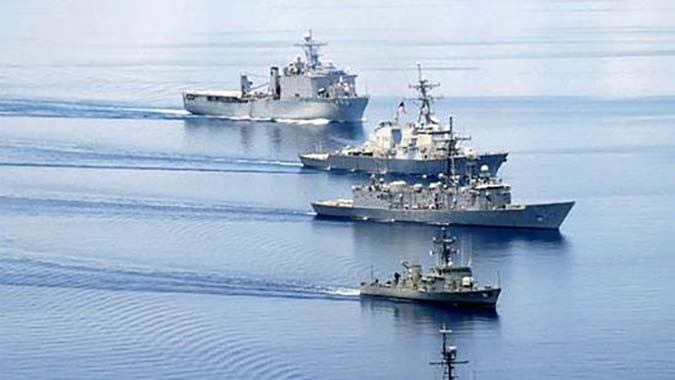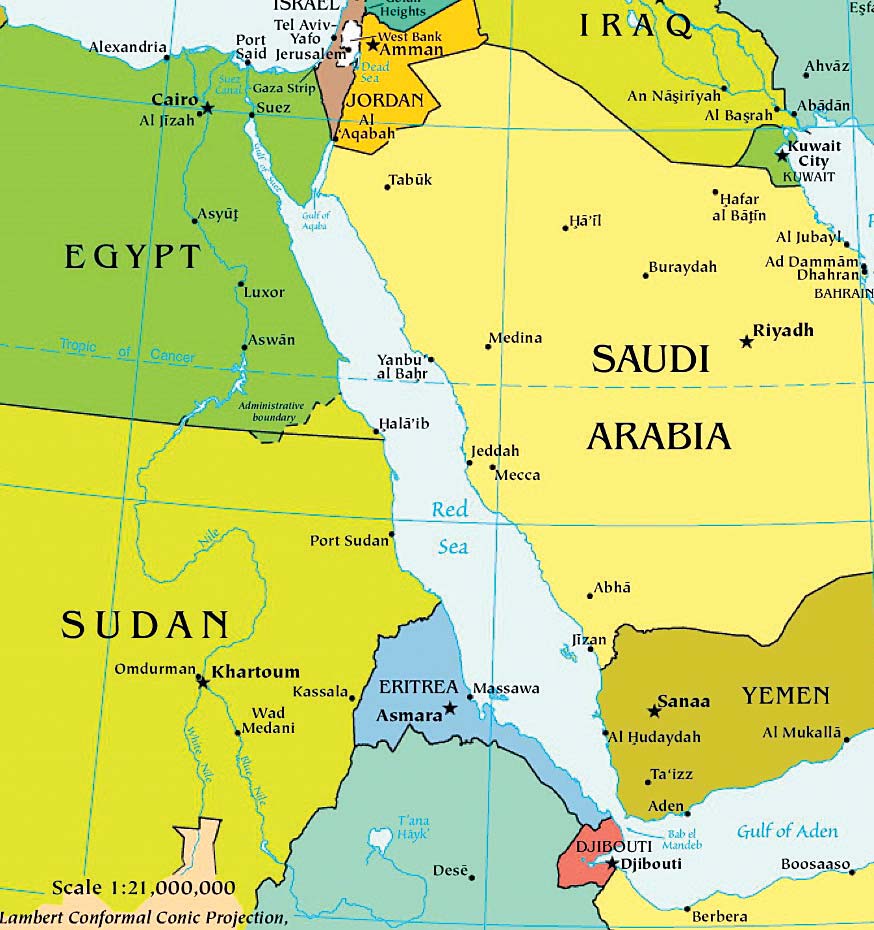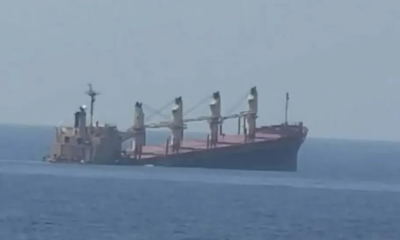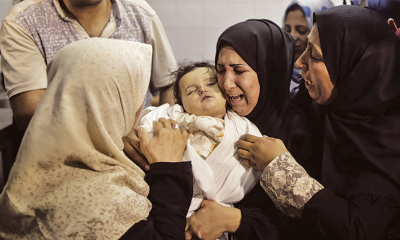Features
Big power brinkmanship and that elusive ship in Red Sea

By Lasanda Kurukulasuriya
There appears to be confusion over diverse reports on the deployment of a Sri Lanka Navy ship in the Red Sea, to participate in a US-led military operation against Houthi ship attacks. President Ranil Wickemesinghe has remarked on this mission at various events, but it is still not clear whether a vessel is to be sent, has already been sent, or will not be sent.
Over the past several weeks, media reports have conveyed that:
– The Red Sea deployment to join the US-led “Operation Prosperity Guardian” is unlikely, as none of the Offshore Patrol Vessels in service with the SLN are equipped to operate in a missile environment (The Island 07.02.24)
– No ship has still been sent (The Sunday Times 18.02.24 citing a foreign ministry source)
– At a TV panel discussion on ‘Sovereignty, geopolitics and citizens’ on 28.02 24, none of the panelists referred to a ship having been dispatched on this mission, although the subject came up. Had such an event transpired, it’s unlikely that none on that panel had learnt of it (TV1 News1st 28.02.24, Face the Nation)
– That same day US ambassador Julie Chung at an Indian Ocean Conference organised by the Pathfinder Foundation said: “We have donated 3 former US Coast Guard Cutters to Sri Lanka’s Navy and provided a variety of other security assistance. We recently witnessed SL addressing global challenges head-on, and broadening its role on the world stage, by sending one of those donated Cutters to support Operation Prosperity Guardian that the president mentioned. The Sri Lankan Navy joined a multinational coalition of naval vessels in the Red Sea, Gulf of Aden and the Arabian Sea from over a dozen countries, to help safeguard the freedom of navigation and protect the busy sea lanes of commercial ship traffic from Houthi attacks.” (TV1 News1st 9pm English news 28.02.24)
Given that there has been no credible confirmation of the status of this mission for two months, it would appear the ambassador was taking her cue from remarks by the president at the conference, where he’s on record saying that “The freedom of navigation has led us now, to take part in the Operation Prosperity Guardian in the Red Sea.”
Thereafter The Island on 01.03.24 reported that there will be ‘No Red Sea deployment.’ It said: “Contradicting a claim made by US Ambassador Julie Chung the previous day, authoritative sources denied the deployment of an Offshore Patrol Vessel (OPV) in support of operation ‘Prosperity Guardian’ in the Red Sea to combat Houthis.” The report cited sources saying that two OPVs, SLNS Sayura (P 620) and SLNS Gajabahu (P 626) had been deployed on a special several weeks long mission in the Arabian Sea, on an anti-narcotic operation. SLNS Gajabahu had returned to Colombo whereas SLNS Sayura was on its way back.
Protecting economic interests
At two subsequent events however, President Wickremesinghe, who is Commander in Chief of the Armed Forces, again asserted the intention to participate in the US-led military operation. At a SLAF Cadets Commissioning ceremony held at Trincomalee Airbase on 29.02.24 he reportedly said “Our security forces have played a significant role in safeguarding the state of Mali from terrorism, earning appreciation from others for their efforts. In the event of our economic rights being compromised in the Red Sea, we are steadfast in our commitment to protecting them. Consequently, should issues arise concerning regional or global peace, we pledge to extend the necessary support to the United Nations Organization.” (President’s Media Division, translation)
The next day (01.03.24) at the SLN Fleet Review at Trincomalee Harbour, he asserted: “It is imperative that we prevent any harm to our economic endeavours in the Indian Ocean. Furthermore, we have made arrangements to deploy our navy for the security of the Red Sea. Recalling the adverse effects of the closure of the Suez Canal during the 1967 Israeli-Arab war, which halted operations at the Colombo port for a decade, underscores the necessity of safeguarding the Indian Ocean. .. I am confident that our navy will effectively undertake this responsibility in the future. (PMD, translation)
The president has made some points justifying participation in the Red Sea military operations against Houthis. One was, protecting Sri Lanka’s economic interests that would be harmed by disruption of trade transiting the vital sea channel. But is the comparison with the 1967 closure of the Suez Canal and its impact on Colombo Port, relevant in the present context? The SL Ports Authority remarked that more ships were calling in Colombo Port owing to the need to take the longer route around Africa. SLPA chairman Keith Bernard reportedly said that container volumes at the SLPA owned terminal had seen an 80% growth. One way or another, given the volatility of the situation the long term outcome would seem unpredictable.
The resolve to protect Sri Lanka’s ‘economic rights’ in the far-away Red Sea also draws attention to economic deprivation nearer home, where Northern fishermen are protesting their loss of livelihood owing to the longstanding issue of poaching by Indian fishermen in Sri Lankan waters (not to mention severe degradation of the marine environment that continues unabated).Wouldn’t this be a more immediate task relating to ‘preventing harm to our economic endeavours in the Indian Ocean?’
Regional and global peace
At Trincomalee Airbase, the president referred to the significant role of Sri Lankans participating in UN Peacekeeping operations in Mali, an African state fighting terrorism, and pledged to extend Sri Lanka’s support to the UN on issues concerning regional or global peace. The ongoing military exercise against Houthis in the Red Sea however is not a UN operation, as in the case of Mali, but a campaign initiated by the US with a few allies. The Houthis say they are targeting ships linked to Israel in protest against its war on Gaza, and that they will stop their attacks no sooner Israel ends its onslaught.
The president has, at the same time, supported the call for a ceasefire in Gaza and statehood for Palestine, and made other sympathetic statements and moves such as setting up a ‘Children of Gaza Fund’ in aid of the war-affected children. But with the US facilitating the carnage in Gaza by continuing to supply arms to Israel, and vetoing Security Council resolutions for a humanitarian ceasefire, it is difficult to reconcile these sentiments with his eagerness to respond to the US call. Many analysts are of the view that the US-UK led strikes in the Red Sea are escalating the war, not helping to end it.
The US meanwhile having seen the ‘cracks in the armour’ of Sri Lanka’s professed Non Alignment, has lost no time pushing for deeper maritime and defence ties, in a location that has become a geopolitical flashpoint in the context of big power rivalry. US Deputy Secretary of State Richard Verma during a Feb 23-24 visit to Sri Lanka announced the donation of a fourth Coast Guard Cutter to the SL Navy.
“Very, very grateful for your leadership and participating in the “Operation Prosperity Guardian,” the efforts in the Red Sea,” he told the president. “Just again excited about the prospect of contributing to further ties, whether on maritime domain awareness, whether on counter terrorism training, whatever area we can do together to strengthen the peace, security and stability of the Indian Ocean region.”
It’s of interest that he also visited the West Container Terminal of Colombo Port, for the expansion of which the US recently announced a US$553 million loan through its International Development Finance Corporation. The fact that this finance is supplied to the Adani group which holds a 51% stake in the project has been downplayed in US communications. When the IDFC loan was announced ft.com reported “The US will lend $553mn for the development of a container terminal in Sri Lanka operated by Indian tycoon Gautam Adani as Washington works to counter China’s influence in the country.”
It should not be forgotten that India is designated a ‘major defence partner’ of the US – advancing defence trade and technology sharing with India ‘to a level at par with that of the United States’ closest allies and partners,’ according to a joint statement issued at the time. Sri Lanka has signed numerous agreements with India, with little transparency, in vital sectors that could radically alter the economic landscape in years ahead, potentially worsening the asymmetry in the Indo-Lanka power balance.
Ambassador Chung also attended the signing of an MoU between the US National Nuclear Security Administration and the Sri Lanka Navy at the Navy Headquarters on 28.02.24. According to an SLN statement “The MoU addressed bilateral cooperation to detect and interdict illicit trafficking in special nuclear material and other radioactive material through technical and methodological cooperation, including the installation and improvement of technical systems for the detection and identification of such material at border crossing control points of the democratic socialist republic of Sri Lanka.” ‘Border crossing control points’ would presumably refer to the country’s ports and airports, key strategic assets for any country.
Features
The heart-friendly health minister

by Dr Gotabhya Ranasinghe
Senior Consultant Cardiologist
National Hospital Sri Lanka
When we sought a meeting with Hon Dr. Ramesh Pathirana, Minister of Health, he graciously cleared his busy schedule to accommodate us. Renowned for his attentive listening and deep understanding, Minister Pathirana is dedicated to advancing the health sector. His openness and transparency exemplify the qualities of an exemplary politician and minister.
Dr. Palitha Mahipala, the current Health Secretary, demonstrates both commendable enthusiasm and unwavering support. This combination of attributes makes him a highly compatible colleague for the esteemed Minister of Health.
Our discussion centered on a project that has been in the works for the past 30 years, one that no other minister had managed to advance.
Minister Pathirana, however, recognized the project’s significance and its potential to revolutionize care for heart patients.
The project involves the construction of a state-of-the-art facility at the premises of the National Hospital Colombo. The project’s location within the premises of the National Hospital underscores its importance and relevance to the healthcare infrastructure of the nation.
This facility will include a cardiology building and a tertiary care center, equipped with the latest technology to handle and treat all types of heart-related conditions and surgeries.
Securing funding was a major milestone for this initiative. Minister Pathirana successfully obtained approval for a $40 billion loan from the Asian Development Bank. With the funding in place, the foundation stone is scheduled to be laid in September this year, and construction will begin in January 2025.
This project guarantees a consistent and uninterrupted supply of stents and related medications for heart patients. As a result, patients will have timely access to essential medical supplies during their treatment and recovery. By securing these critical resources, the project aims to enhance patient outcomes, minimize treatment delays, and maintain the highest standards of cardiac care.
Upon its fruition, this monumental building will serve as a beacon of hope and healing, symbolizing the unwavering dedication to improving patient outcomes and fostering a healthier society.We anticipate a future marked by significant progress and positive outcomes in Sri Lanka’s cardiovascular treatment landscape within the foreseeable timeframe.
Features
A LOVING TRIBUTE TO JESUIT FR. ALOYSIUS PIERIS ON HIS 90th BIRTHDAY

by Fr. Emmanuel Fernando, OMI
Jesuit Fr. Aloysius Pieris (affectionately called Fr. Aloy) celebrated his 90th birthday on April 9, 2024 and I, as the editor of our Oblate Journal, THE MISSIONARY OBLATE had gone to press by that time. Immediately I decided to publish an article, appreciating the untiring selfless services he continues to offer for inter-Faith dialogue, the renewal of the Catholic Church, his concern for the poor and the suffering Sri Lankan masses and to me, the present writer.
It was in 1988, when I was appointed Director of the Oblate Scholastics at Ampitiya by the then Oblate Provincial Fr. Anselm Silva, that I came to know Fr. Aloy more closely. Knowing well his expertise in matters spiritual, theological, Indological and pastoral, and with the collaborative spirit of my companion-formators, our Oblate Scholastics were sent to Tulana, the Research and Encounter Centre, Kelaniya, of which he is the Founder-Director, for ‘exposure-programmes’ on matters spiritual, biblical, theological and pastoral. Some of these dimensions according to my view and that of my companion-formators, were not available at the National Seminary, Ampitiya.
Ever since that time, our Oblate formators/ accompaniers at the Oblate Scholasticate, Ampitiya , have continued to send our Oblate Scholastics to Tulana Centre for deepening their insights and convictions regarding matters needed to serve the people in today’s context. Fr. Aloy also had tried very enthusiastically with the Oblate team headed by Frs. Oswald Firth and Clement Waidyasekara to begin a Theologate, directed by the Religious Congregations in Sri Lanka, for the contextual formation/ accompaniment of their members. It should very well be a desired goal of the Leaders / Provincials of the Religious Congregations.
Besides being a formator/accompanier at the Oblate Scholasticate, I was entrusted also with the task of editing and publishing our Oblate journal, ‘The Missionary Oblate’. To maintain the quality of the journal I continue to depend on Fr. Aloy for his thought-provoking and stimulating articles on Biblical Spirituality, Biblical Theology and Ecclesiology. I am very grateful to him for his generous assistance. Of late, his writings on renewal of the Church, initiated by Pope St. John XX111 and continued by Pope Francis through the Synodal path, published in our Oblate journal, enable our readers to focus their attention also on the needed renewal in the Catholic Church in Sri Lanka. Fr. Aloy appreciated very much the Synodal path adopted by the Jesuit Pope Francis for the renewal of the Church, rooted very much on prayerful discernment. In my Religious and presbyteral life, Fr.Aloy continues to be my spiritual animator / guide and ongoing formator / acccompanier.
Fr. Aloysius Pieris, BA Hons (Lond), LPh (SHC, India), STL (PFT, Naples), PhD (SLU/VC), ThD (Tilburg), D.Ltt (KU), has been one of the eminent Asian theologians well recognized internationally and one who has lectured and held visiting chairs in many universities both in the West and in the East. Many members of Religious Congregations from Asian countries have benefited from his lectures and guidance in the East Asian Pastoral Institute (EAPI) in Manila, Philippines. He had been a Theologian consulted by the Federation of Asian Bishops’ Conferences for many years. During his professorship at the Gregorian University in Rome, he was called to be a member of a special group of advisers on other religions consulted by Pope Paul VI.
Fr. Aloy is the author of more than 30 books and well over 500 Research Papers. Some of his books and articles have been translated and published in several countries. Among those books, one can find the following: 1) The Genesis of an Asian Theology of Liberation (An Autobiographical Excursus on the Art of Theologising in Asia, 2) An Asian Theology of Liberation, 3) Providential Timeliness of Vatican 11 (a long-overdue halt to a scandalous millennium, 4) Give Vatican 11 a chance, 5) Leadership in the Church, 6) Relishing our faith in working for justice (Themes for study and discussion), 7) A Message meant mainly, not exclusively for Jesuits (Background information necessary for helping Francis renew the Church), 8) Lent in Lanka (Reflections and Resolutions, 9) Love meets wisdom (A Christian Experience of Buddhism, 10) Fire and Water 11) God’s Reign for God’s poor, 12) Our Unhiddden Agenda (How we Jesuits work, pray and form our men). He is also the Editor of two journals, Vagdevi, Journal of Religious Reflection and Dialogue, New Series.
Fr. Aloy has a BA in Pali and Sanskrit from the University of London and a Ph.D in Buddhist Philosophy from the University of Sri Lankan, Vidyodaya Campus. On Nov. 23, 2019, he was awarded the prestigious honorary Doctorate of Literature (D.Litt) by the Chancellor of the University of Kelaniya, the Most Venerable Welamitiyawe Dharmakirthi Sri Kusala Dhamma Thera.
Fr. Aloy continues to be a promoter of Gospel values and virtues. Justice as a constitutive dimension of love and social concern for the downtrodden masses are very much noted in his life and work. He had very much appreciated the commitment of the late Fr. Joseph (Joe) Fernando, the National Director of the Social and Economic Centre (SEDEC) for the poor.
In Sri Lanka, a few religious Congregations – the Good Shepherd Sisters, the Christian Brothers, the Marist Brothers and the Oblates – have invited him to animate their members especially during their Provincial Congresses, Chapters and International Conferences. The mainline Christian Churches also have sought his advice and followed his seminars. I, for one, regret very much, that the Sri Lankan authorities of the Catholic Church –today’s Hierarchy—- have not sought Fr.
Aloy’s expertise for the renewal of the Catholic Church in Sri Lanka and thus have not benefited from the immense store of wisdom and insight that he can offer to our local Church while the Sri Lankan bishops who governed the Catholic church in the immediate aftermath of the Second Vatican Council (Edmund Fernando OMI, Anthony de Saram, Leo Nanayakkara OSB, Frank Marcus Fernando, Paul Perera,) visited him and consulted him on many matters. Among the Tamil Bishops, Bishop Rayappu Joseph was keeping close contact with him and Bishop J. Deogupillai hosted him and his team visiting him after the horrible Black July massacre of Tamils.
Features
A fairy tale, success or debacle

Sri Lanka-Singapore Free Trade Agreement
By Gomi Senadhira
senadhiragomi@gmail.com
“You might tell fairy tales, but the progress of a country cannot be achieved through such narratives. A country cannot be developed by making false promises. The country moved backward because of the electoral promises made by political parties throughout time. We have witnessed that the ultimate result of this is the country becoming bankrupt. Unfortunately, many segments of the population have not come to realize this yet.” – President Ranil Wickremesinghe, 2024 Budget speech
Any Sri Lankan would agree with the above words of President Wickremesinghe on the false promises our politicians and officials make and the fairy tales they narrate which bankrupted this country. So, to understand this, let’s look at one such fairy tale with lots of false promises; Ranil Wickremesinghe’s greatest achievement in the area of international trade and investment promotion during the Yahapalana period, Sri Lanka-Singapore Free Trade Agreement (SLSFTA).
It is appropriate and timely to do it now as Finance Minister Wickremesinghe has just presented to parliament a bill on the National Policy on Economic Transformation which includes the establishment of an Office for International Trade and the Sri Lanka Institute of Economics and International Trade.
Was SLSFTA a “Cleverly negotiated Free Trade Agreement” as stated by the (former) Minister of Development Strategies and International Trade Malik Samarawickrama during the Parliamentary Debate on the SLSFTA in July 2018, or a colossal blunder covered up with lies, false promises, and fairy tales? After SLSFTA was signed there were a number of fairy tales published on this agreement by the Ministry of Development Strategies and International, Institute of Policy Studies, and others.
However, for this article, I would like to limit my comments to the speech by Minister Samarawickrama during the Parliamentary Debate, and the two most important areas in the agreement which were covered up with lies, fairy tales, and false promises, namely: revenue loss for Sri Lanka and Investment from Singapore. On the other important area, “Waste products dumping” I do not want to comment here as I have written extensively on the issue.
1. The revenue loss
During the Parliamentary Debate in July 2018, Minister Samarawickrama stated “…. let me reiterate that this FTA with Singapore has been very cleverly negotiated by us…. The liberalisation programme under this FTA has been carefully designed to have the least impact on domestic industry and revenue collection. We have included all revenue sensitive items in the negative list of items which will not be subject to removal of tariff. Therefore, 97.8% revenue from Customs duty is protected. Our tariff liberalisation will take place over a period of 12-15 years! In fact, the revenue earned through tariffs on goods imported from Singapore last year was Rs. 35 billion.
The revenue loss for over the next 15 years due to the FTA is only Rs. 733 million– which when annualised, on average, is just Rs. 51 million. That is just 0.14% per year! So anyone who claims the Singapore FTA causes revenue loss to the Government cannot do basic arithmetic! Mr. Speaker, in conclusion, I call on my fellow members of this House – don’t mislead the public with baseless criticism that is not grounded in facts. Don’t look at petty politics and use these issues for your own political survival.”
I was surprised to read the minister’s speech because an article published in January 2018 in “The Straits Times“, based on information released by the Singaporean Negotiators stated, “…. With the FTA, tariff savings for Singapore exports are estimated to hit $10 million annually“.
As the annual tariff savings (that is the revenue loss for Sri Lanka) calculated by the Singaporean Negotiators, Singaporean $ 10 million (Sri Lankan rupees 1,200 million in 2018) was way above the rupees’ 733 million revenue loss for 15 years estimated by the Sri Lankan negotiators, it was clear to any observer that one of the parties to the agreement had not done the basic arithmetic!
Six years later, according to a report published by “The Morning” newspaper, speaking at the Committee on Public Finance (COPF) on 7th May 2024, Mr Samarawickrama’s chief trade negotiator K.J. Weerasinghehad had admitted “…. that forecasted revenue loss for the Government of Sri Lanka through the Singapore FTA is Rs. 450 million in 2023 and Rs. 1.3 billion in 2024.”
If these numbers are correct, as tariff liberalisation under the SLSFTA has just started, we will pass Rs 2 billion very soon. Then, the question is how Sri Lanka’s trade negotiators made such a colossal blunder. Didn’t they do their basic arithmetic? If they didn’t know how to do basic arithmetic they should have at least done their basic readings. For example, the headline of the article published in The Straits Times in January 2018 was “Singapore, Sri Lanka sign FTA, annual savings of $10m expected”.
Anyway, as Sri Lanka’s chief negotiator reiterated at the COPF meeting that “…. since 99% of the tariffs in Singapore have zero rates of duty, Sri Lanka has agreed on 80% tariff liberalisation over a period of 15 years while expecting Singapore investments to address the imbalance in trade,” let’s turn towards investment.
Investment from Singapore
In July 2018, speaking during the Parliamentary Debate on the FTA this is what Minister Malik Samarawickrama stated on investment from Singapore, “Already, thanks to this FTA, in just the past two-and-a-half months since the agreement came into effect we have received a proposal from Singapore for investment amounting to $ 14.8 billion in an oil refinery for export of petroleum products. In addition, we have proposals for a steel manufacturing plant for exports ($ 1 billion investment), flour milling plant ($ 50 million), sugar refinery ($ 200 million). This adds up to more than $ 16.05 billion in the pipeline on these projects alone.
And all of these projects will create thousands of more jobs for our people. In principle approval has already been granted by the BOI and the investors are awaiting the release of land the environmental approvals to commence the project.
I request the Opposition and those with vested interests to change their narrow-minded thinking and join us to develop our country. We must always look at what is best for the whole community, not just the few who may oppose. We owe it to our people to courageously take decisions that will change their lives for the better.”
According to the media report I quoted earlier, speaking at the Committee on Public Finance (COPF) Chief Negotiator Weerasinghe has admitted that Sri Lanka was not happy with overall Singapore investments that have come in the past few years in return for the trade liberalisation under the Singapore-Sri Lanka Free Trade Agreement. He has added that between 2021 and 2023 the total investment from Singapore had been around $162 million!
What happened to those projects worth $16 billion negotiated, thanks to the SLSFTA, in just the two-and-a-half months after the agreement came into effect and approved by the BOI? I do not know about the steel manufacturing plant for exports ($ 1 billion investment), flour milling plant ($ 50 million) and sugar refinery ($ 200 million).
However, story of the multibillion-dollar investment in the Petroleum Refinery unfolded in a manner that would qualify it as the best fairy tale with false promises presented by our politicians and the officials, prior to 2019 elections.
Though many Sri Lankans got to know, through the media which repeatedly highlighted a plethora of issues surrounding the project and the questionable credentials of the Singaporean investor, the construction work on the Mirrijiwela Oil Refinery along with the cement factory began on the24th of March 2019 with a bang and Minister Ranil Wickremesinghe and his ministers along with the foreign and local dignitaries laid the foundation stones.
That was few months before the 2019 Presidential elections. Inaugurating the construction work Prime Minister Ranil Wickremesinghe said the projects will create thousands of job opportunities in the area and surrounding districts.
The oil refinery, which was to be built over 200 acres of land, with the capacity to refine 200,000 barrels of crude oil per day, was to generate US$7 billion of exports and create 1,500 direct and 3,000 indirect jobs. The construction of the refinery was to be completed in 44 months. Four years later, in August 2023 the Cabinet of Ministers approved the proposal presented by President Ranil Wickremesinghe to cancel the agreement with the investors of the refinery as the project has not been implemented! Can they explain to the country how much money was wasted to produce that fairy tale?
It is obvious that the President, ministers, and officials had made huge blunders and had deliberately misled the public and the parliament on the revenue loss and potential investment from SLSFTA with fairy tales and false promises.
As the president himself said, a country cannot be developed by making false promises or with fairy tales and these false promises and fairy tales had bankrupted the country. “Unfortunately, many segments of the population have not come to realize this yet”.
(The writer, a specialist and an activist on trade and development issues . )

























